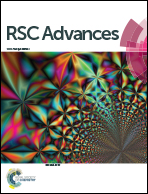Enhancement of volatile fatty acid production using semi-continuous anaerobic food waste fermentation without pH control†
Abstract
This study proposed a cost-effective and high-yield volatile fatty acid (VFA) production strategy using anaerobic food waste (FW) fermentation without pH control, which could be recommended for practical scale VFA production and FW treatment. Efficient hydrolysis, high VFA production (867.42 mg COD per g of VS) and VFA/SCOD (88.65%), and slight methane production (20.56 mL per g of VS, only 5.34% of theoretical value) were obtained via semi-continuous anaerobic FW fermentation under the optimized conditions, which were a substrate to inoculum ratio of 5, a temperature of 40 °C, a solid retention time of 7 d and an organic loading rate of 9 g VS per L per d. The highly-efficient VFA production was mainly attributed to the proper pH, which was not adjusted artificially and was maintained at 5.2–6.4 by the neutralization effect of ammonia release. And both the kinetic model and the carbon mass balance analysis showed that the substrate was adequately utilized to produce VFA under the optimized conditions. These results were of great guiding significance for the practical continuous recovery of VFA from FW.


 Please wait while we load your content...
Please wait while we load your content...